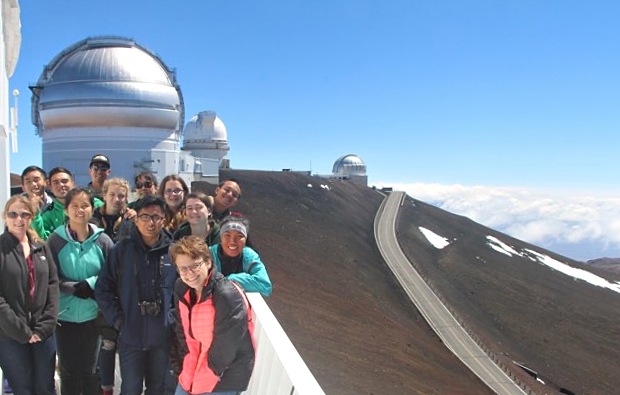Maunakea Scholars Program Expands
The Maunakea Scholars program, designed to bring Hawai‘i’s high school students into one of the world’s most advanced observatory communities, has dramatically expanded for the 2017-18 school year to serve more local kids.
The program announced its tremendous growth on Thursday, Oct. 5, 2017, at the Future Focus Technology and Research Conference.
Approximately 200 students will participate in the 2017-18 school year.
Launched in 2015 and now working with its third cohort of student astronomers, the program has seen explosive growth to keep pace with demand from local schools as the only partnership of its kind internationally.
The number of participating schools has doubled with an increase from five to 10 participating schools from 2016-17 and three at the program’s inception. Participating schools include: Honoka‘a, Kohala, Kealakehe and Waiakea on the Big Island; King Kekaulike on Maui; Moloka‘i High School; and Kalani, Waipahu, Kapolei and Nanakuli high schools on Oahu.
Participants used 10 telescope facilities, an increase from two observatory participants at the program’s inception. They include Canada-France-Hawai’i Telescope (CFHT), Gemini Observatory, East Asian Observatory, Las Cumbres Observatory, NASA Infrared Telescope Facility, Subaru Telescope, W.M. Keck Observatory, United Kingdom Infrared Telescope, Robo-AO, a University of Hawai’i (UH) affiliated telescope, and the Smithsonian Submillimeter Array.
An innovative curriculum was development as a result of the newly-formed Maunakea Scholars Working Group, created in the official partnership agreement penned by the Hawai‘i State Department of Education and UH with the Maunakea Observatories in May of 2017.
The program works by pairing a professional astronomy mentor with the students in each participating school to coach them through the process of interpreting astronomy data and crafting an original research proposal.
The proposals are submitted to a time allocation community for consideration, and projects are awarded highly-valuable time on participating telescopes based on the merit and viability of the proposals.
Research ideas have included eclipsing x-ray binary systems, an in-depth look at star forming regions and how they retain their shapes, study of possible life in other areas of the solar system and comparing elements in different supernova remnants and more.
Throughout the year, Maunakea Scholars supports each classroom with educational resources, including an integrated indigenous Hawaiian perspective to modern science education, led by ‘Imiloa Astronomy Center’s MANU ‘Imiloa program.
‘Imiloa was created to respond to the Western dichotomy view of “science” vs. “culture” by providing a space where the two can coalesce, where culture makes science relevant, and where new and improved solutions become possible. This holistic approach can make science learning more effective and allows Maunakea Scholar students to understand what they are observing in more impactful way.
“The Maunakea Scholars program is an unprecedented program, a collaboration between the Department of Education, the University of Hawai‘i and Maunakea Observatories, coming together for the purpose of providing amazing opportunities to the next generation,” ‘Imiloa Astronomy Center Executive Director Ka‘iu Kimura.
About the Maunakea Observatories
The Maunakea Observatories are a collaboration of independent institutions with telescopes located on Maunakea on the island of Hawai’i. Together, the Observatories make Maunakea the most scientifically productive site for astronomy world-wide. The Maunakea Observatories include: Caltech Submillimeter Observatory, Canada-France-Hawai’i Telescope, Gemini International Observatory, James Clerk Maxwell Telescope (EAO), NASA Infrared Telescope Facility, Subaru Telescope, Submillimeter Array, United Kingdom Infrared Telescope, University of Hawai’i Hilo Educational Telescope, University of Hawai’i 2.2 Meter Telescope, Very Long Baseline Array, W. M. Keck Observatory (Keck I and Keck II).
Sponsored Content
Comments









